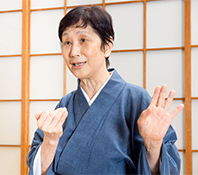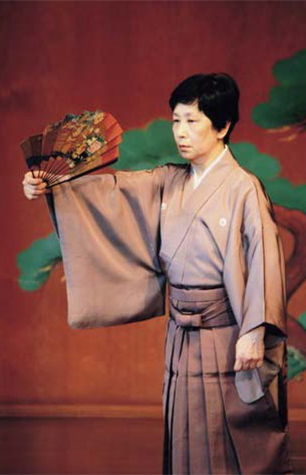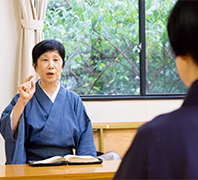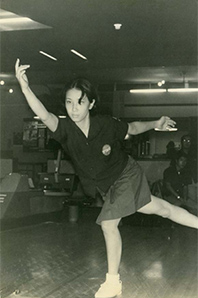Yoko Yamamura, Noh performer, Kanze-ryu (Kanze Style, Umewaka-kai), Organizer of the Dojo for the Voice
Female Noh performer who presides over the Dojo for the Voice in pursuit of a truly inspirational voice
Devoted herself to bowling during her Keio days

Yoko Yamamura,
Noh performer, Kanze-ryu (Kanze Style, Umewaka-kai),
Organizer of the Dojo for the Voice
Born in 1948 in Ukiha District (presently Ukiha City), Fukuoka Prefecture. Graduated from Keio Girls Senior High School and the Faculty of Business and Commerce of Keio University. Encountered Noh and started taking lessons. Became Noh master (shihan) of main role acting (shite kata) in the Kanze-ryu style at the recommendation of master Rokuro Umewaka at the age of 42, after marriage and raising a family of four. Organized the group Kokoromi no Kai, which explores the possibilities of Noh while transcending style and gender, and Dojo for the Voice, which teaches breathing techniques to help individuals improve their voice naturally. Author of Dojo for the Voice: The Japanese Voice is in Danger (2010) and Dojo for the Voice II: An Encouragement of Haihai, Hai (2012) (both published by Issei Publishing).
Encounters Noh in Fukuoka after college graduation and dedicates herself to practice
─ Ms. Yoko Yamamura is a female Noh performer. We tend to think that, like Kabuki, Noh performance is a men’s world, but it seems that female performers are active, too.
Noh, which boasts a history of 650 years, was long performed by men alone. In fact, female Noh performers only joined the ranks of men after World War II. Presently, about 1400 Noh performers are registered in the Nohgaku Performers’ Association, of which about 200 are women. I became a professional Noh performer in 1988, but back then, female Noh performers were mostly either those who had been born into a family related to Noh, or those who had been taking lessons since childhood. As for myself, though my parents used to practice Noh as a hobby, I was brought up in a family that had nothing to do with professional Noh. In addition, I was into bowling during my school days at Keio and got a late start with Noh at the age of 24.

─ What aspects of Noh were you attracted to?
When I returned to Fukuoka to my parents’ place after spending 7 years in Tokyo as a student, my parents had invited a Noh teacher to our home and were practicing on a wooden floor stage which had once been an eight-tatami room. Out of respect for my parents, I joined the practice and tried playing the kotsuzumi (shoulder drum), but I couldn’t get the right sound. It was so frustrating that I gave up bowling and started to practice Noh passionately. Instruments used in Noh are the fue or kotsuzumi (shoulder drum), taiko (stick drum); these 4 instruments altogether are called shibyoshi (the four rhythms). I started with the kotsuzumi, then went on to the fue and the taiko, and ended up learning all of the instruments. By then, I was already hooked. I tend to get into something easily, and I think I like myself when I am immersed in something. Alongside the instruments, I also wanted to acquire shimai (Noh dance) and utai or yokyoku (singing), and I immersed myself in practice, even neglecting my marriage! (laughs)
I did have a desire to become a Noh performer, but thought it impossible for me to become one, since it is difficult even for those born into a Noh family. I decided to consider it a hobby. Still, my romance with Noh remained unchanged, so much that I only accepted a marriage proposal at age thirty under the condition that I be able to continue practicing Noh.
─ And now, you are active as a professional Noh performer. How did that happen?
Because of my husband’s business, I returned to live in Tokyo again soon after I got married. My teacher in Fukuoka introduced me to Mr. Rokuro Umewaka (who was later named the second Gensho Umewaka), and I continued my Noh practice under him. I gave birth to two children, which kept me away from Noh for a while, but after a few years, Master Umewaka contacted me. “More women are aiming to become Noh performers, so we want to form a society for such women. Won’t you join us by obtaining a professional degree?” he asked, inviting me into the society. I had to put a lot of thought into this because my second child had just entered preschool. However, the people around me gave me the courage to decide to take the path of becoming a Noh performer. That was when I was 40 years old. I obtained the master’s certificate when I was 42.
By the way, in shite kata (main role acting), there are styles other than Kanze-ryu; others include Komparu-ryu, Kongo-ryu, Hosho-ryu and Kita-ryu. Shite kata only focuses on dancing and singing, but since Noh is a composite art, you need to have good knowledge of everything. Learning to play the four instruments before getting married may have led me to becoming a professional Noh performer.
Kokoromi no Kai, which transcends style and gender, and Dojo for the Voice, which applies traditional Japanese vocalization techniques to voice training
─ After that, while teaching dancing and singing of Noh, you organized Dojo for the Voice: The Japanese Voice is in Danger.
The main objective of the Kokoromi no Kai, which can be translated as “society of endeavor”, is to think about Noh in terms of women. However, with cooperation from many masters, it has also been a way to make endeavors into Noh in a literal sense, expanding Noh’s possibilities by transcending style and gender. We are in our 13th year and held our 10th performance in April. During the Noh play Semimaru, thirty-something female performers of Kita-ryu and Kanze-ryu performed the tsure (companion to the main role). The ji-utai chorus were all women as well. I was one of the chorus members, and also danced Yokihi, a short play called maibayashi. We asked Master Tojiro Yamamoto, who became a Living National Treasure in July, and his family to take part in the Kyogen play. Due in part to the success of our ten performances, we have decided to suspend activities in order to prepare for a new direction.
I began Dojo for the Voice in 2007 due to the gradual increase in the number of students who came to me to receive voice training lessons for Noh. Most of these people used their voice in their profession, such as in acting and narrating. When I asked them why they learned Noh vocalization, they told me that their voice wouldn’t carry on stage or that they had difficulty maintaining a stable voice when narrating. Although they received voice training in the Western tradition, they felt uncomfortable when applying it to Japanese lines or narration. I also heard that even those who were interested in taking Noh lessons felt that it was too unfamiliar, or that they were reluctant to become an apprentice of a certain master. In other words, the needs of these people were practical; they came to improve their voice, not to brush up their Noh performance.

As a matter of fact, in Kadensho (“The Book of Transmission of the Flower”), a classic book on dramatic theory written by Zeami, the originator of Noh, there is explanation about “oral transmission on vocalization”, and he explains from back then how to use your breath when emitting your voice when singing. This leads to the fundamentals of vocalization of the Japanese language. Therefore, I decided to open the Dojo for the Voice for actors and narrators, a training school focusing on vocalization rather than practice of Noh. When I actually started the Dojo, it was surprising that not all of the students used their voice in their profession, but half of them were ordinary people, such as the school teacher whose problem was that his voice wouldn’t carry throughout the classroom or the housewife who felt she had lost her voice with age.
─ Certainly, there are probably many people who feel that they go unheard in everyday life. What do you teach at the Dojo?
The basics are abdominal breathing and posture. But even before that, I get people to understand the difference of vocalization between Japanese and Western languages such as English or French. When you count “Ichi, ni, san, yon…” in Japanese, your mouth does not move much vertically, and your lower jaw hardly moves. However, when you count “one, two, three, four…” in English, your mouth moves vertically, and your lower jaw moves actively. In Japanese, you can pronounce a consonant at the tip of your mouth, so you can speak without really using your breath. But in English, you need more breath to speak since you have to open your mouth vertically and use your jaw, whereby breath escapes from your nose. Many who speak Western languages naturally know how to breathe deeply using the abdomen, but many Japanese people need training on breathing.
When practicing abdominal breathing at the Dojo, we first straighten our posture. It doesn’t matter if you sit on the floor or in a chair, but you slightly open your knees, straighten your back and neck, and adjust your posture as if you are pushing your navel downward and forward, so that you are sitting on your seat bones. When you do this, you should relax your shoulders, and should be careful not to stick out your chest and chin. Then, you concentrate on exhaling, trying not to bother about inhaling. When you exhale deeply, air comes in naturally, rather than having to consciously breathe it in. When you put your hands on your lower abdomen, you can feel it swell, and this way you can confirm your abdominal breathing.
Then, let out your voice using your abdominal breathing. If you have a correct posture and if your back is straight, you should feel that using your strong breath from your abdomen, your voice that comes out through your vocal cords hits your upper jaw, and your body acts as a sounding board so that your voice reverberates strongly. Based on this breathing and vocalization, the aim of Dojo for the Voice is to acquire, and to speak with, your natural voice that reverberates with the listener’s heart.
I wrote my book so that more people can acquire the basics of breathing. The reason for its subtitle, “The Japanese Voice is in Danger,” is because I fear that many Japanese are not good at abdominal breathing to start with. To add to this, with their computers and video games when growing up, the number of people with bad posture has increased, so many people lack a clear voice that can be heard properly.
Becoming a pro bowler was a possibility during college days at Keio
─ Could you please tell us about your memories of Keio Girls Senior High School and Keio University? As for university, I proceeded to the Faculty of Business and Commerce. 40 years ago, there certainly were female students who would start their careers working for companies or continue with their studies after graduation, but there were also many students who would return home to get married, and I was one of them. So, I went easy on studying, and the main part of my campus life revolved around bowling, which was just gaining popularity back then. I would gather with my friends at Mita Bowling Center* (Mita Bowl) to enjoy bowling. Around that time, I was scouted by the Bowling Club, a bowling circle at Keio University, because they were short of members as Ms. Kyoko Nagahara, who later became a professional bowler, graduated and left the club. I tend to get really into something once I start, and after practicing for a while, my average score went up to 180.
My father, who was born during the Meiji period, was a graduate of the Faculty of Economics. I was born in the Ukiha District (presently Ukiha City) of Fukuoka Prefecture as the third daughter and youngest of six children. My maiden name is Kawakita. My father respected Yukichi Fukuzawa, and with his encouragement, all of his children except for my eldest sister studied at Keio. We had a house in Tokyo where all my brothers and sisters lived together and went to school.
I graduated from Keio Girls Senior High School in its 15th year. I was full of energy, and was really into playing volleyball. My teacher once found me climbing up a tree in the schoolyard and laughed at me, calling me “ochappi”. This is probably a dead word now (laughs), but it means a tomboyish and cheerful girl. I remember fondly that in my second year, we wanted to hold our own school festival rather than doing it together with Keio Senior High School, so I became one of the members of the planning committee, and we started the “Kanna Festival”. I forgot the details, but I remember that we served

After that, my life was all about bowling, and even if I didn’t show up in the classroom, I would be at Mita Bowl (laughs). I also worked part time at Mita Bowl. Our women’s team was at the top level among university teams, and we used to win various competitions. My highest score was 245, which I achieved at the East Japan University Competition. I also went on TV, participating in an intercollegiate bowling competition, and was interviewed by a magazine. At one point, I considered going professional, but after graduating from Keio University, the subject of my devotion changed to Noh. Still, I have many fond memories from my bowling days.
─ Finally, could you please give some words of wisdom to Keio University students?
I think it is important both to study hard and to be passionate in something else which will enrich your school life and future life. And what’s really important is to live every moment seriously. Also, I would like to pass on to Keio students what is said to be the final poem of Shinsaku Takasugi: “Let us make an uninteresting world interesting, the mind is the only thing that counts.”
─ Thank you very much.
*Opened in September 1964 in Mita 5-chome near Keio Girls Senior High School. Closed in April 1973.
-This article appeared in the 2012 autumn edition (No.276) of “Juku.”
-Position titles, etc., are those at the time of publishing.
